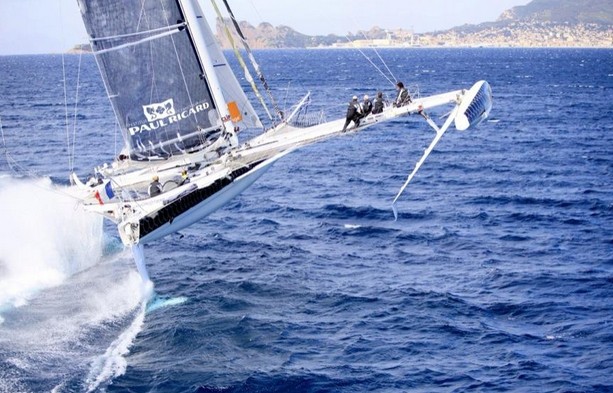Engineer Alain Thebault is aiming at a new record. The sailboat designer, who began his career as a teenager wanting to build a boat that would fly, has previously set the sailing speed record with his Hydrofoil, which achieved 50 knots average speed (95km/h) in 2009. Thebault is aiming for a much higher sail speed, and he aims to do it by sailing at four times the speed of wind–something that has never been done before.
Thebault’s new project is the Hydroptere Rocket. Thebault teamed with an Aeronautics engineer-led group under Philippe Perrier of Dassault Aviation and Maurice Prat of Airbus to launch the iDroptere, a glider boat which aims to push the absolute sailing speed record to 80 knots (150 km/h).
Assembly of the iDroptere Rocket has begun in the Gulf of Saint-Tropez.
 “This is great news!” said Thebault. “We look forward to attending the launch of Hydroptere Rocket in the Mediterranean. Our first objective will be sailing between Lausanne and Geneva for Syz and Co Sailing Speed Records, and between Hyères and La Ciotat to climb the wall of 80 knots under sail!”
“This is great news!” said Thebault. “We look forward to attending the launch of Hydroptere Rocket in the Mediterranean. Our first objective will be sailing between Lausanne and Geneva for Syz and Co Sailing Speed Records, and between Hyères and La Ciotat to climb the wall of 80 knots under sail!”
“My interest in this is to do some things that nobody has done before,” said Perrier. “Basically, hydrodynamics and aerodynamics are quite the same. The main difference is density of water, which is 800 time the one of air. But, when you go to high speed, some differences may appear.”
“In the air, you have the speed of sound, which is the sound barrier, and this creates different phenomena as the plane is pushing its noise and its perturbation in front of it. This changes completely the way it behaves.”
“The speed of sound in water is very high, so nobody will ever get it.”
“But there is another phenomenon, which is called ‘cavitation.’ At the upper side of the foil in the water you get such low pressure that the water starts to uprise, and when this starts to occur–it starts around 40-45 knots, it takes place more around 50 knots, and when you up to 55 knots, you can consider that all the upper side of the foil doesn’t work anymore in the water, but it works in the vapor of water.”
“And this changes completely the behavior in a way that is comparable to sonic and supersonic differences in aerodynamics.”
“We consider that in order to go at more than 65 knots, we must try to do it with a lower speed of wind. That means that our goal is to get 80 knots with only 20 knots of wind.”
“That means that the speed of the boat is four times the speed of the wind. This has never been done before.”
A foil that is capable of working efficiently at over 80 knots is one of the challenges the team faces, Perrault said, and referred to technical engineering partnerships the group has made, which has given them confidence that the goal is achievable.
Photo: Hydroptere
